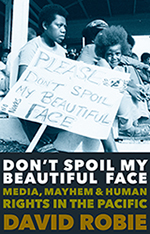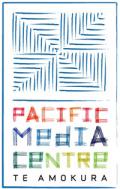_cover_french%20crs%20vs%20kanaks%20NC1984%20web%20550wide.jpg)
Alison McCulloch profiles Pacific Media Centre director David Robie, his new book and his lifetime commitment to media coverage of the Asia-Pacific region.
REVIEW: Well of course we’d rather read about the pregnancy of Monaco’s Princess Charlene than about media crackdowns in Timor-Leste or the run-up to Fiji’s first post-coup elections. What were you thinking? Journalists who cover the South Pacific are long used to being ignored in New Zealand’s mainstream news media. If our location was mapped according to the international focus of our Fourth Estate, New Zealand would probably lie somewhere in the Atlantic.
Coverage of Pacific nations by the New Zealand media tends to hover around 5 percent or less, depending on the research and the medium being looked at, with Radio New Zealand a notable exception. And it’s not just the quantity that’s wanting. A 2006 study showed that when there is coverage in New Zealand’s print media, Pacific people tend to be portrayed as unmotivated, unhealthy and criminal ‘others’ who are overly dependent on Palagi (Pākehā) support.
David Robie has been slogging away on the front lines of Asia-Pacific journalism for decades, both as a practitioner and a journalism educator. His new book “Don’t Spoil My Beautiful Face: Media, Mayhem & Human Rights in the Pacific,” chronicles that work through reprints of his writing and reporting, coupled with some fresh context, follow-ups and personal recollections. The range of nations and outrages is broad, and he wraps up the book with a look at the media itself.
It’s not as though these Pacific stories lack the elements that make for hard news, as Robie makes clear in his Epilogue: “A decade-long civil war on Bougainville, four coups in Fiji (if the ill-fated George Speight putsch is counted), ethnic conflict in the Solomon Islands, factional feuding in Vanuatu and political assassinations in Samoa have all been part of the volatile mix in recent years.” Then there are the riots in Tahiti and Tonga; independence struggles in Kanaky/New Caledonia, Timor-Leste and, more recently, West Papua; Cook Island tax havens, violence against women; the impact of global warming; Australia’s cruel asylum policy and our own panic-mongering over the boat people who haven’t even clambered into their boats yet; and on it goes.
 Because of its focus on Robie’s own reporting, this book isn’t intended to be a complete survey of what’s topical in the region now, nor a comprehensive history of the recent past, and this can leave the reader wanting more. Rediscovering some of the region’s anti-colonial conflicts in these pages highlights the need for a focused study of where the individual states (and the region) are at, and where they’re headed. (To that end, a plea for someone with deep pockets to fund Robie and his students and colleagues so they can do more journalism and write more books.)
Because of its focus on Robie’s own reporting, this book isn’t intended to be a complete survey of what’s topical in the region now, nor a comprehensive history of the recent past, and this can leave the reader wanting more. Rediscovering some of the region’s anti-colonial conflicts in these pages highlights the need for a focused study of where the individual states (and the region) are at, and where they’re headed. (To that end, a plea for someone with deep pockets to fund Robie and his students and colleagues so they can do more journalism and write more books.)
Filling the gaps
The updates he adds to each piece do fill some of those gaps, though a close look at the footnoting suggests there might not have been enough time (or resources) for too much fresh reporting. The chapter on “indigenous struggles” for example, includes a fascinating report Robie did for the Listener in 1989 about the Lubicon Cree fight for land rights in the Canadian state of Alberta, which has parallels with Māori land struggles. That article is updated with news of a $700 million lawsuit filed last year by the Lubicon Cree accusing state and federal governments of theft of their natural resources. Clearly, there’s been a lot going on in the 25 years since Robie’s initial report, and a short update can’t really do it justice.
 Similarly, the coda to a 1996 article about the imprisonment in Tonga of an MP and two journalists includes intriguing comments by Kalafi Moala (one of the imprisoned, who also wrote the foreword to this book), that express his disillusionment with elements of the very pro-democracy movement he helped foster. “In fact,” Robie writes, “Moala blames some of the pro-democracy leaders of carrying part of the responsibility for unleashing the November 2006 Nuku ‘alofa riots”. (Eight people died and scores were arrested in the riots, which destroyed much of the city centre.) There are hints here of an important story about how progressive movements in the Pacific can go wrong.
Similarly, the coda to a 1996 article about the imprisonment in Tonga of an MP and two journalists includes intriguing comments by Kalafi Moala (one of the imprisoned, who also wrote the foreword to this book), that express his disillusionment with elements of the very pro-democracy movement he helped foster. “In fact,” Robie writes, “Moala blames some of the pro-democracy leaders of carrying part of the responsibility for unleashing the November 2006 Nuku ‘alofa riots”. (Eight people died and scores were arrested in the riots, which destroyed much of the city centre.) There are hints here of an important story about how progressive movements in the Pacific can go wrong.
It’s worth noting that in his foreword to this book, Moala praises Robie for the role he played in raising awareness of the arrest and jailing of the “Tongan three”, including helping organise a petition seeking their release. “Without David’s involvement,” Moala writes, “the story and reaction to our imprisonment would not have been so widely known.” It’s a comment that brings us right back to where we started: Perhaps if we had a news media that did a better job of covering the Pacific, that petition wouldn’t have been needed.
Precisely why three-quarters of New Zealand’s international news coverage is about the richer, more developed “minority world”, as a study by Donald Matheson at Canterbury University shows, is an interesting question. Matheson suggests it’s because “journalism practice is stuck in a colonial heritage and in an insular Anglo-Americanism” – which also helps explain the us-them approach to writing about Māori issues, and a surprisingly similar paucity of coverage – less than 3 percent of total stories in newspapers. But why is it so insular? Like many journalists and academics before him, Matheson has some good ideas, but with so much solid media analysis and critique already under our belt, it’s surely clear by now that more analysis and critique aren’t going to bring about change.
Contemporary issues
Robie touches on some of these practitioner issues in the final few chapters of the book, which because of their contemporary relevance, are among the most interesting. He challenges the “monocultural” way we do news, and points to other approaches, among them what he calls “critical development journalism”: Instead of seeing everything through the lens of conflict – “on the one hand this, on the other hand that” – which precludes complexity and nuance, how about a journalism that is allowed some “subjectivity” (horror of horrors!); that is sourced from the grassroots not just the elite; that is community and public-interest focused; that is, well, not so “monocultural”? Haven’t we had enough “Gotcha!” by now?
Easier said than done. Looking at careers like Robie’s – and this book includes more biographical material than his other works – the best hope seems no longer to lie in trying to change corporate journalism, but in going around it. At AUT’s Pacific Media Centre, Robie and his students and colleagues are doing just that, maintaining a website (on a shoestring) that’s simply the best place to go for Pacific news. (It also has a home at Pacific Scoop, a sister-site to Werewolf on the Scoop platform.) On top of that, Robie blogs at Café Pacific and edits Pacific Journalism Review, which is about to celebrate its 20th birthday.
Still, one can’t help but hope that the shocking, sad, fascinating, exciting, scary, moving, heart-breaking, depressing, uplifting stories in this book will remind our mainstream practitioners of just how newsworthy our own neighbourhood is. Even in the Western news media paradigm, “proximity” is supposed to count for something.
Don’t Spoil My Beautiful Face: Media, Mayhem & Human Rights in the Pacific, by David Robie. (Little Island Press/Pacific Media Centre, 2014.)
References:
“People like us: The cultural geography of New Zealand’s international news,” by Donald Matheson. In Scooped: The Politics and Power of Journalism in Aotearoa New Zealand, eds Martin Hirst, Sean Phelan & Verica Rupar. (AUT Media, 2012.)
“Pasifika in the News: The Portrayal of Pacific Peoples in the New Zealand Press,” by Robert Loto, Darrin Hodgetts, Kerry Chamberlain, Linda Waimarie Nikora, Rolinda Karapu & Alison Barnett. Journal of Community & Applied Psychology, 16: 100-18 (2006)
“Content and source analysis of newspaper items about Māori issues: Silencing the ‘natives’ in Aotearoa?” by Jenny Rankine, Angela Moewaka Barnes, Tim McCreanor, Ray Nairn, Ana-Lyse McManus, Sue Abel, Belinda Borrell & Amanda Gregory. Pacific Journalism Review, 20 (1): 213-33 (May 2014)
Republished from Werewolf with permission.
 MORE ARTICLES
MORE ARTICLES
Sedition, e-libel the new media frontline
'Climate of censorship' chills Pacific media scene
New free press book a must read for 'media spoilers'
New book focusing on 'secret history' of the Pacific [audio]
David Robie's new book should be on shelves of Pacific newsrooms
New book on South Pacific journalism looks at region's history and challenges
David Robie blasts media attackers at book launch [video]
Journalism can be an agent of peace
Gavin Ellis reviews the book on Radio NZ [audio]
E-libel laws the new frontline in the Pacific battle for press freedom [The Conversation]
Richard Aedy interviews David on ABC Media Report [audio]



